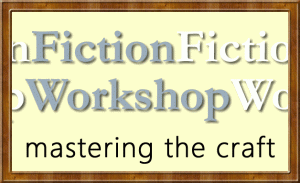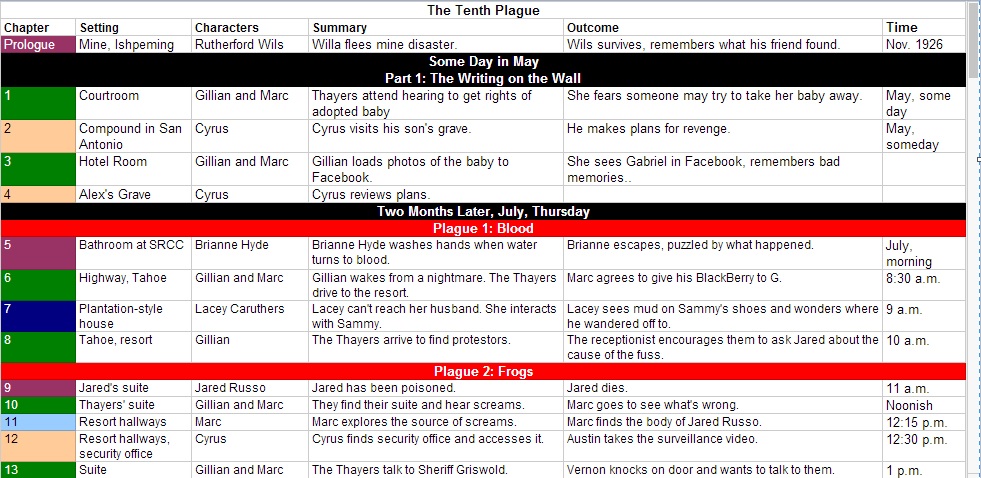How to Plot Your Novel with a Simple Spreadsheet
 Have you ever wondered what a novel looks like in a spreadsheet? The outline, I mean.
Have you ever wondered what a novel looks like in a spreadsheet? The outline, I mean.
Maybe you’re wondering what a novel outline even is. When I say outline, what pops in your head? Is it something like this?
I. This is the first heading.
A. This is a subheading.
1. This is a subsubheading.
No, I’m not referring to an outline for a high school English term paper. I’m referring to a novel. When I say outline, I’m merely referring to some kind of organizational structure behind the story—a blueprint, if you will, that shows all the critical ingredients that must work together behind the scenes for the story to work.
You may be surprised to learn how many organizational details must work together to make a good story, especially for a suspense novel with multiple characters and settings on a timeline.
There are actually lots of ways to organize and plan novels. Some creative authors use a “mindmap” with Post-it Notes and stick them to a wall. Each note is a scene, a slice of action with at least one character, some sort of action, and then some kind of outcome. They use different colors to identify different characters or subplots.
I can’t take full credit for how I outline my novels. I already had a system I was using, but when I read Revision & Self-Editing by James Scott Bell and saw his advice for using a spreadsheet, a bell went off in my head. I began using spreadsheets in Google Drive.
I took the idea from James Scott Bell, modified it for my own purposes, and came up with what I call a “chapter plan.” Here’s what I used to keep track of the plan of my latest novel, The Tenth Plague. This is an unedited sample of what it looks like (and the plan continues for more than one hundred chapters). Click on it for a larger version.
As you can see, each horizontal line represents a chapter (in that novel every scene is a chapter) and supplies several categories of important information: chapter number, setting, characters, summary, outcome, and time. The spreadsheet is a great way to get a bird’s eye view of everything going on in the story.
I also used color at the far left to keep track of who has the point of view in a given scene. Gillian, my lead character, has hunter green. Cyrus, my villain, has beige. I even used red to keep track of when the various biblical plagues occur in the story.
Now, what are the ingredients of a powerful scene and why? We’ll talk about that next time.
Got any questions about how to organize a suspense novel? If you’ve written a novel and used another organizational approach, I’d love to hear how you did it. What worked for you? What didn’t? Feel free to send me your questions or comments.











I like this a lot, Adam. Much thanks to you and the inimitable James Scott Bell. I’ll have to incorporate this technique during my plotting sessions going forward. 🙂
You’re welcome, Sybil. I’m glad the chapter plan helped you.
Pingback: Today's Author | 8 Steps All Writers Follow When They Edit
Pingback: Outlining by the Seat of my Pants | Lana Voynich
Pingback: 8 Steps All Writers Follow When They Edit | WordDreams...
This is great! I already use something similar for individual scenes to help me track emotions, GMC, and the 5 senses, but I’ve not used one for a novel as a whole.
Is each chapter in your writing comprised of just one scene? If no, how do you account for the individual scenes within a spreadsheet like this?
Pingback: Outlining A Novel In Microsoft Excel – Fluent Historian
Thanks for sharing your spreadsheet. It helps by bringing much needed order for long-term fiction projects.
This sounds great!
Thanks for sharing your spreadsheet
How did you do the thing where you separated rows with columns of color? I’m new to Excel. Thanks!
Hi, Faith. I actually created the spreadsheet in Google Docs, and there is a setting there for adding color to rows. You may want to check it out.
You’re welcome. I’m glad it’s helpful.
Hi Adam, I love the spreadsheet idea, how do you get the unnumbered rows in Google Docs? I can not see how you add a row that is not is sequence with the others? IE: blank row chapter, blank row prologue, blank row “some day in may”, row 1, row 2, row 3, row 4, blank row “two months later” (and so on). Please can you help?
Hi, Rich. Have you used Google Docs? If so, simply make a spreadsheet (any number of rows or columns). Click in any row, go to above menu, and select “Insert,” “Row above.” A new row will be inserted above current row with same columns. Select entire row including designation for columns. Then in menu select “merge cells” icon. There you go! You now have a row that is clean of numbers and any columns. You can then make the row whatever color you want and type in whatever you wish. I hope that helps. Feel free to shoot me more questions. I’m happy to help.
Hi Adam, many thanks for your help!
Anytime. I’m glad to help. The spreadsheet has helped me so much.
I just came across this on Pinterest as I’m trying to find my personal style for outlining a longer piece of fiction. I really like this, but more importantly I GET IT and can actually do it!
Hi, Paul. I’m so glad the spreadsheet has helped you. Novels require so much organization, and this definitely helps.
Thank you for your time in sharing your spreadsheet idea for plot development. I especially like the POV colors for each scene. (for others) I took your example and replicated it in MAC Numbers. There is a previously created spreadsheet in Numbers for creating a Travel itinerary (which is 100% editable). I even added one extra spreadsheet for scene development as a reminder for my plot development as to why the characters are acting or interacting the way they are. I can even add images as needed. But most important, this style you have shared keeps it simple and to the point. Much appreciated and thank you again.
Best Regards,
Wayne
Thank you <3
This is exactly what I was looking for Sooz, so thank you very much. I m in the last quarter of my novel and had been wracking my brains about how to start a synopsis and your guide was so perfectly simple and logical, I ended up writing it in about thirty minutes. In retrospect, it seemed easier to write the book itself, but this guide was invaluable. Cheers!
Hi, Eden. I’m glad my spreadsheet is helpful. It was so helpful to me, I figured it might help somebody else, too.
Hi, Lam. You’re welcome. Glad to help.
Hi, Wayne. I’m so glad the spreadsheet is so helpful. I’ve gotten more feedback and kind thoughts about it than anything else I’ve ever posted.